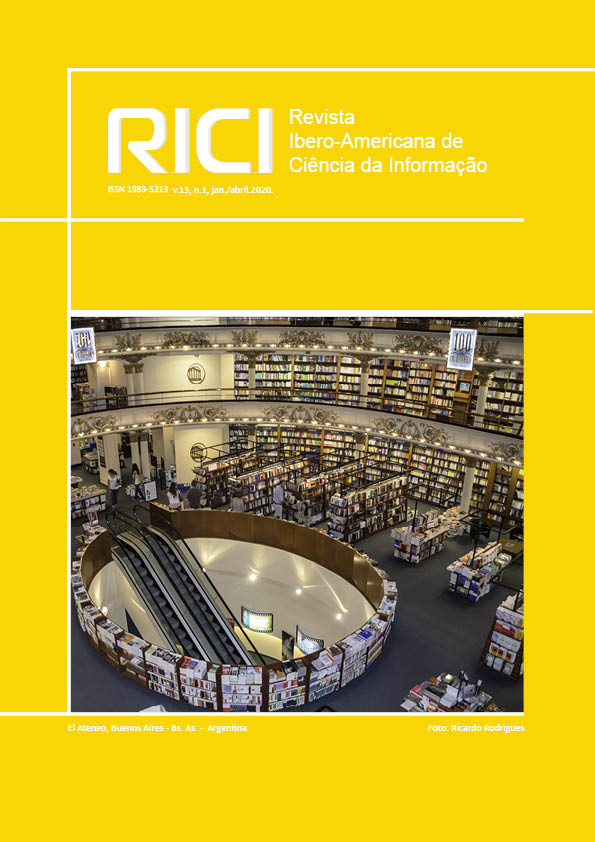Software for digital repositories: evaluation for the management and preservation of bibliographic materials and archival documents of the National Library of Brazil
DOI:
https://doi.org/10.26512/rici.v13.n1.2020.29554Keywords:
digital preservation. digital repository. evaluation. national library. Brazil.Abstract
The Information and Communication Technology changed the way of the National Library of Brazil to produce, use and store information, if before its collection was composed of palimpsest, papyrus, books and administrative documents on paper support, it is currently also composed for digital objects (native and digitized) such as books, magazines, newspapers, music, photographs, administrative documents among others; and the number of these digital objects are growing every day. Therefore, the research evaluated and analyzed the characteristics and functionalities of the software for digital repositories Archivematica, DSpace and RODA in order to identify the most suitable for the management and preservation of bibliographic materials and archival documents of the National Library of Brazil. The organizational structure of the National Library of Brazil and the specialized bibliography were reviewed; The softwares selected were analyzed using a quantitative criterion based on the functionalities they fulfill. DSpace was the one that presented the best result, fulfills 92% of the selected functionalities. In second place is RODA, with a level of satisfaction of 77% and lastly is Archivematica, with 62%. Archivematica is not a digital repository software, but a digital preservation system, that is, a technological solution for a digital repository. RODA, is an OAIS preservation software and not a publishing platform. DSpace is the most suitable software for the management and preservation of bibliographic materials and archival documents of the National Library of Brazil, serving 92% of the functionalities considered as the most important and relevant for management and preservation.
Downloads
References
ÁLVAREZ WONG, B. Los repositorios digitales para la conservación. Un acercamiento a la preservación digital a largo plazo. Ciencias de la Información, v. 48; n.2, p. 15-22, 2017. Recuperado de: http://www.redalyc.org/articulo.oa?id=181454540003
ALVITE, M.; RODRÃGUEZ, B. Evaluación de interfaces de OPACs implementadas con UNICORN en las Universidades madrileñas. III Jornadas españolas de bibliotecas digitales. Madrid: Universidad Politécnica de Madrid, 2002. Recuperado de: https://buleria.unileon.es/bitstream/handle/10612/3068/UNICORN%20en%20universidades%20madrile%C3%B1as.pdf?sequence=4
BANKIER J. G.; Gleason K. Institutional Repository Software Comparison.2014. Recuperado de: https://unesdoc.unesco.org/ark:/48223/pf0000227115
BRASIL. CONSELHO NACIONAL DE ARQUIVOS. Diretrizes para a implementação de repositórios digitais confiáveis de documentos arquivísticos. Rio de Janeiro: Arquivo Nacional, 2014. Recuperado de: http://conarq.arquivonacional.gov.br/images/publicacoes_textos/diretrizes_rdc_arq.pdf
BRASIL. CONSELHO NACIONAL DE ARQUIVOS. e-ARQ Brasil: Modelo de Requisitos para Sistemas Informatizados de Gestão Arquivística de Documentos. Rio de Janeiro: Arquivo Nacional, 2011. Recuperado de: http://conarq.arquivonacional.gov.br/images/publicacoes_textos/earqbrasil_model_requisitos_2009.pdf
BRASIL. Decreto 8.297/2014, de 15 de agosto de 2014, aprova o Estatuto e o Quadro de Demonstrativo dos Cargos em Comissão da Fundação Biblioteca Nacional. Diário Oficial da República Federativa do Brasil, 2014. Recuperado de: http://www.planalto.gov.br/ccivil_03/_Ato2011-2014/2014/Decreto/D8297.htm
BRASIL. Decreto 8.539/2015, de 8 de outubro de 2015, dispõe sobre o uso do meio eletrônico para realização do processo administrativo. Diário Oficial da República Federativa do Brasil,2015. Recuperado de: http://www.planalto.gov.br/ccivil_03/_Ato2015-2018/2015/Decreto/D8539.htm
HEMINGER, A.; ROBERTSON, S. The Digital Rosetta Stone: A Model for Maintaining Long-term Access to Static Digital Documents. Communications of the Association for Information Systems, 3, 2000.
MASREK M.N. HAKIMJAVADI, H. Evaluation of Three Open Source Software in Terms of Managing Repositories of Electronic Theses and Dissertations: A Comparison Study. Journal of Basic and Applied Scientific Research, v. 2; n. 11, 2012. Recuperado de: https://pdfs.semanticscholar.org/4f20/fa7f78e82ed10b57ec0eb6e54dd29e23d0f1.pdf?_ga=2.31173943.928927258.1563125175-1286103302.1560078805
MATEUS, J. C. O Governo Eletrónico, a sua aposta em Portugal e a importância das Tecnologias de Comunicação para a sua estratégia. Revista de Estudos Politécnicos, v. 4; n. 9, p. 31-52, 2008. Recuperado de: http://www.scielo.mec.pt/pdf/tek/n9/n9a02.pdf
POLANCO-CORTÉS, J. Repositorios digitales: Definición y pautas para su creación, 2014. Recuperado de: https://ucrindex.ucr.ac.cr/docs/repositorios-digitales-definicion-y-pautas-para-su-creacion.pdf
ROSA, C. A., CRAVEIRO, O.; DOMINGUES, P. Open source software for digital preservation repositories: A survey. International Journal of Computer Science and Engineering Survey (IJCSES), v. 8; n. 3, 2017. Recuperado de: https://arxiv.org/abs/1707.06336
TEXIER, J. Repositorio de Documentos Administrativos para la Universidad Nacional Experimental del Táchira (REDAUNET). 2013. Recuperado en: http://eprints.rclis.org/20813/
Downloads
Published
How to Cite
Issue
Section
License
Copyright Notice
Authors who publish in this journal agree to the following terms:
- Authors retain copyright and grant the journal right of first publication with the work simultaneously licensed under the Creative Commons Attribution License 4.0, allowing the sharing of work and recognition of the work of authorship and initial publication in this journal.
- Authors are able to take on additional contracts separately, non-exclusive distribution of the version of the paper published in this journal (ex.: distribute to an institutional repository or publish as a book), with an acknowledgment of its initial publication in this journal.
- Authors are permitted and encouraged to distribute their work online (eg.: in institutional repositories or on their website) at any point before or during the editorial process, as it can lead to productive exchanges, as well as increase the impact and citation the published work.
















